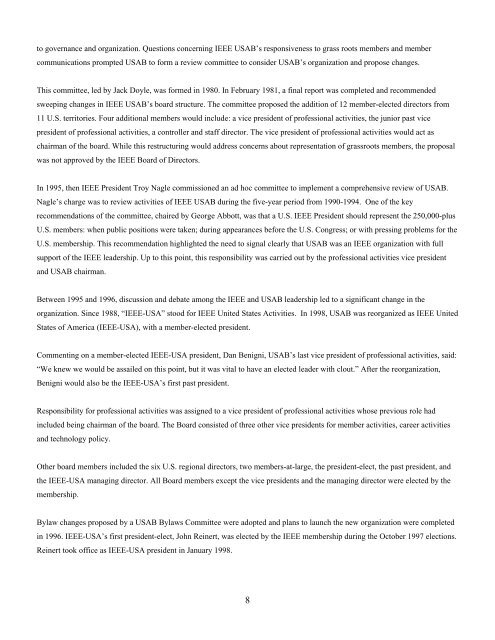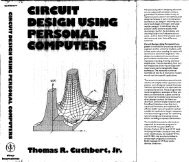History of IEEE-USA: 1973-2009 â An Overview of Four Decades ...
History of IEEE-USA: 1973-2009 â An Overview of Four Decades ...
History of IEEE-USA: 1973-2009 â An Overview of Four Decades ...
You also want an ePaper? Increase the reach of your titles
YUMPU automatically turns print PDFs into web optimized ePapers that Google loves.
to governance and organization. Questions concerning <strong>IEEE</strong> <strong>USA</strong>B’s responsiveness to grass roots members and member<br />
communications prompted <strong>USA</strong>B to form a review committee to consider <strong>USA</strong>B’s organization and propose changes.<br />
This committee, led by Jack Doyle, was formed in 1980. In February 1981, a final report was completed and recommended<br />
sweeping changes in <strong>IEEE</strong> <strong>USA</strong>B’s board structure. The committee proposed the addition <strong>of</strong> 12 member-elected directors from<br />
11 U.S. territories. <strong>Four</strong> additional members would include: a vice president <strong>of</strong> pr<strong>of</strong>essional activities, the junior past vice<br />
president <strong>of</strong> pr<strong>of</strong>essional activities, a controller and staff director. The vice president <strong>of</strong> pr<strong>of</strong>essional activities would act as<br />
chairman <strong>of</strong> the board. While this restructuring would address concerns about representation <strong>of</strong> grassroots members, the proposal<br />
was not approved by the <strong>IEEE</strong> Board <strong>of</strong> Directors.<br />
In 1995, then <strong>IEEE</strong> President Troy Nagle commissioned an ad hoc committee to implement a comprehensive review <strong>of</strong> <strong>USA</strong>B.<br />
Nagle’s charge was to review activities <strong>of</strong> <strong>IEEE</strong> <strong>USA</strong>B during the five-year period from 1990-1994. One <strong>of</strong> the key<br />
recommendations <strong>of</strong> the committee, chaired by George Abbott, was that a U.S. <strong>IEEE</strong> President should represent the 250,000-plus<br />
U.S. members: when public positions were taken; during appearances before the U.S. Congress; or with pressing problems for the<br />
U.S. membership. This recommendation highlighted the need to signal clearly that <strong>USA</strong>B was an <strong>IEEE</strong> organization with full<br />
support <strong>of</strong> the <strong>IEEE</strong> leadership. Up to this point, this responsibility was carried out by the pr<strong>of</strong>essional activities vice president<br />
and <strong>USA</strong>B chairman.<br />
Between 1995 and 1996, discussion and debate among the <strong>IEEE</strong> and <strong>USA</strong>B leadership led to a significant change in the<br />
organization. Since 1988, “<strong>IEEE</strong>-<strong>USA</strong>” stood for <strong>IEEE</strong> United States Activities. In 1998, <strong>USA</strong>B was reorganized as <strong>IEEE</strong> United<br />
States <strong>of</strong> America (<strong>IEEE</strong>-<strong>USA</strong>), with a member-elected president.<br />
Commenting on a member-elected <strong>IEEE</strong>-<strong>USA</strong> president, Dan Benigni, <strong>USA</strong>B’s last vice president <strong>of</strong> pr<strong>of</strong>essional activities, said:<br />
“We knew we would be assailed on this point, but it was vital to have an elected leader with clout.” After the reorganization,<br />
Benigni would also be the <strong>IEEE</strong>-<strong>USA</strong>’s first past president.<br />
Responsibility for pr<strong>of</strong>essional activities was assigned to a vice president <strong>of</strong> pr<strong>of</strong>essional activities whose previous role had<br />
included being chairman <strong>of</strong> the board. The Board consisted <strong>of</strong> three other vice presidents for member activities, career activities<br />
and technology policy.<br />
Other board members included the six U.S. regional directors, two members-at-large, the president-elect, the past president, and<br />
the <strong>IEEE</strong>-<strong>USA</strong> managing director. All Board members except the vice presidents and the managing director were elected by the<br />
membership.<br />
Bylaw changes proposed by a <strong>USA</strong>B Bylaws Committee were adopted and plans to launch the new organization were completed<br />
in 1996. <strong>IEEE</strong>-<strong>USA</strong>’s first president-elect, John Reinert, was elected by the <strong>IEEE</strong> membership during the October 1997 elections.<br />
Reinert took <strong>of</strong>fice as <strong>IEEE</strong>-<strong>USA</strong> president in January 1998.<br />
8
















